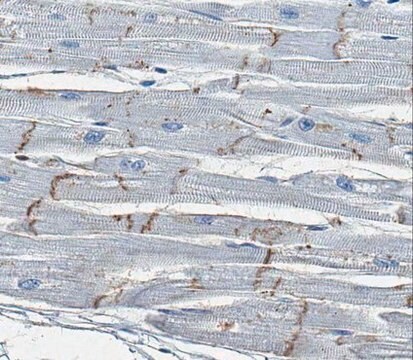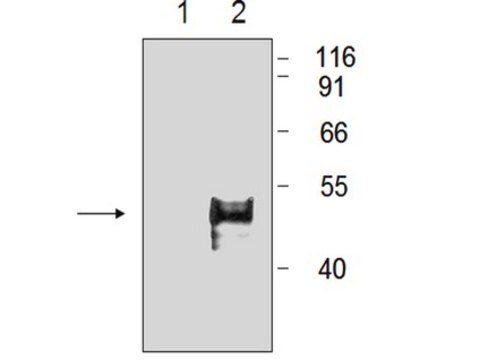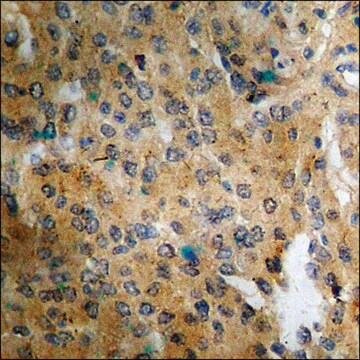AB3768
Anti-Rad54L Antibody
Chemicon®, from rabbit
About This Item
Prodotti consigliati
Origine biologica
rabbit
Livello qualitativo
Forma dell’anticorpo
saturated ammonium sulfate (SAS) precipitated
Tipo di anticorpo
primary antibodies
Clone
polyclonal
Purificato mediante
affinity chromatography
Reattività contro le specie
human, mouse
Produttore/marchio commerciale
Chemicon®
tecniche
immunocytochemistry: suitable
immunohistochemistry: suitable
N° accesso NCBI
N° accesso UniProt
Condizioni di spedizione
dry ice
modifica post-traduzionali bersaglio
unmodified
Informazioni sul gene
human ... RAD54L(8438)
Specificità
Immunogeno
Applicazioni
Immunocytochemistry: 1:200-1:1,000.
Optimal working dilutions must be determined by the end user.SUGGESTED PROTOCOL FOR IMMUNOHISTOCHEMISTRY
1. Dissect tissues and freeze on dry ice
2. Cut on a cryostat - 10um slices
3. Dry slides at room temperature for 30-90 min
4. Fix with cold Acetone/Methanol (50/50) 2 min - then either process further or store at -20°C . Alternative is fixation with 4% PFA and treatment with a trypsin solution. (0.05% trypsin , incubation 10 minutes at 37°C, followed by 3 washes with PBS)
5. Let air dry
6. PBS 5min
7. Incubate in 50mM ammonium chloride 30 min
8. PBS 5min
9. Blocking serum 30-45min
10. Primary antibody 90min - dilution 1:100 - 1:600
11. Wash 3 times for 5 min
12. Secondary fluorescent conjug. antibody 30min
13. Wash 3 times for 5 min and mount
Epigenetics & Nuclear Function
Cell Cycle, DNA Replication & Repair
Stato fisico
PREPARATION AND USE: To reconstitute the antibody, centrifuge the antibody vial at moderate speed (5,000 rpm) for 5 minutes to pellet the precipitated antibody product. Carefully remove the ammonium sulfate/PBS buffer solution and discard. It is not necessary to remove all of the ammonium sulfate/PBS solution: 10 μL of residual ammonium sulfate solution will not effect the resuspension of the antibody. Do not let the protein pellet dry, as severe loss of antibody reactivity can occur.
Resuspend the antibody pellet in any suitable biological buffer, standard PBS or TBS (pH 7.3-7.5) are typical. Volumes required are not critical but it is suggested that the final antibody concentration be between 0.1 mg/mL and 1.0 mg/mL. For example, to achieve a 1 mg/mL concentration with 50 μg of precipitated antibody, the amount of buffer needed would be 50 μL.
Carefully add the liquid buffer to the pellet. DO NOT VORTEX. Mix by gentle stirring with a wide pipet tip or gentle finger-tapping. Let the precipitated antibody rehydrate for 1 hour at 4-25C° prior to use. Small particles of precipitated antibody that fail to resuspend are normal. Vials are overfilled to compensate for any losses.
Stoccaggio e stabilità
Note legali
Esclusione di responsabilità
Non trovi il prodotto giusto?
Prova il nostro Motore di ricerca dei prodotti.
Codice della classe di stoccaggio
12 - Non Combustible Liquids
Classe di pericolosità dell'acqua (WGK)
WGK 2
Punto d’infiammabilità (°F)
Not applicable
Punto d’infiammabilità (°C)
Not applicable
Certificati d'analisi (COA)
Cerca il Certificati d'analisi (COA) digitando il numero di lotto/batch corrispondente. I numeri di lotto o di batch sono stampati sull'etichetta dei prodotti dopo la parola ‘Lotto’ o ‘Batch’.
Possiedi già questo prodotto?
I documenti relativi ai prodotti acquistati recentemente sono disponibili nell’Archivio dei documenti.
Il team dei nostri ricercatori vanta grande esperienza in tutte le aree della ricerca quali Life Science, scienza dei materiali, sintesi chimica, cromatografia, discipline analitiche, ecc..
Contatta l'Assistenza Tecnica.






